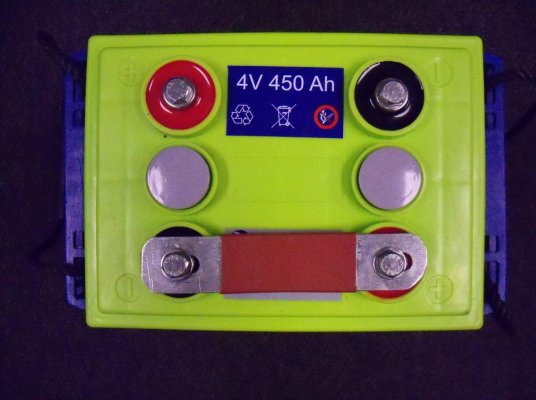Wil
Senior Member
- Joined
- Jul 8, 2013
- Messages
- 187
- Location
- US
- Vessel Name
- Gone Walkabout
- Vessel Make
- 1999 KadeyKrogen 39
My house bank (six T-105+) died, so looking at six Firefly L15/L16 2v-900Ah/4v-450Ah batteries to replace it. Change the regulator and inverter/charger from FLA to AGM, good to go. They'll fit in the battery box nicely (height is Ok), and upgrade charge/discharge/PSOC/AmpHr performance. Spendy though.
These batteries are interesting in that each one can be changed to 2v/900Ah (parallel) or 4v/450Ah (series) configuration. This would allow change to a 24v system with only strap changes, something to do down the road. Attached is a top view of one in 4v series configuration (though missing one strap).
I'm still learning wrt configuring a battery bank, came up with two ways to do these (see pdf). Example 1 would be a 6S2P configuration, Example 2 would be a 2P6S configuration.
Questions:
1) Did I get the terminology right for those configurations?
2) Are those two configurations electrically correct?
3) Is one configuration better than the other for best charge/discharge distribution?
4) I believe both configurations result in a 12v/900Ah bank?
5) Is there another configuration that would be better?
These batteries are interesting in that each one can be changed to 2v/900Ah (parallel) or 4v/450Ah (series) configuration. This would allow change to a 24v system with only strap changes, something to do down the road. Attached is a top view of one in 4v series configuration (though missing one strap).
I'm still learning wrt configuring a battery bank, came up with two ways to do these (see pdf). Example 1 would be a 6S2P configuration, Example 2 would be a 2P6S configuration.
Questions:
1) Did I get the terminology right for those configurations?
2) Are those two configurations electrically correct?
3) Is one configuration better than the other for best charge/discharge distribution?
4) I believe both configurations result in a 12v/900Ah bank?
5) Is there another configuration that would be better?


